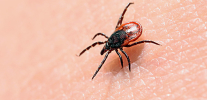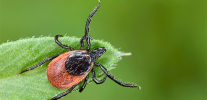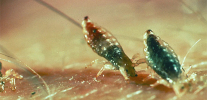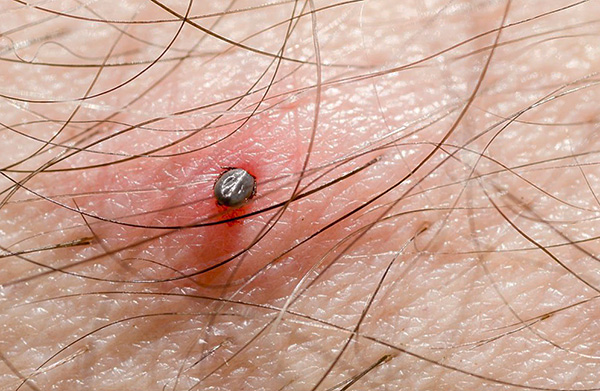
All ixodic ticks are temporary obligate ectoparasites, and a specific feature of their life cycle is a multi-day feeding, during which the tick is still at the place of its attachment to the host body. At this time, the parasite uses the body of the host, not only for food, but also as a true habitat.
At different stages of their development (larva, nymph, imago), the tick bites a suitable victim at least once - blood saturation is a necessary condition for the further development of the organism. In this case, the tick is forced to periodically rebuild from a free-living lifestyle to a parasitic, and vice versa.
Despite these difficulties, ticks have many mechanisms of morphofunctional adaptations to this way of life, which makes them one of the most progressive groups of hemoparasites.
Suspecting and attacking the victim with a tick
One of the most important events in the life cycle of a tick is the finding of a host hungry parasite on which it will feed. On how quickly the tick will find the victim and how fully fed on it, depends on its future life and in part the development of the species as a whole.
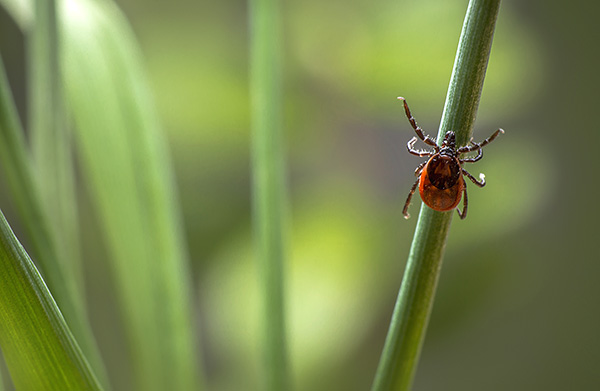
Therefore, the whole nutritional strategy is to use the host as a source of nutrition as efficiently as possible. For this, the tick very carefully selects the places of hunting, the victim and, especially, the place of attachment to it (after all, choosing the wrong place for the bite - this means with a high probability of being detected and killed).
On a note
It has been proven that behavioral responses aimed at finding prey are included only in hungry ticks that have reached the so-called “state of aggressiveness”. In this state, the functioning of the sensory organs and receptors of the tick is activated, and the parasite can effectively perceive the stimuli emanating from the future victim.
In ticks, there are 2 types of search and waiting for prey:
- passive trapping;
- active pursuit.
The passive way is to wait for the victim in places of their frequent accumulation (forest trails, pastures, parks and squares). Much less common is active persecution when the parasite, having sensed the victim, begins to actively move in its direction, approaching it. However, this mechanism is conventionally called an attack - the tick does not pounce on a person or an animal, and contrary to the general opinion does not jump and does not fall from trees.

On a note
Active pursuit is extremely rarely used by ticks, as it requires increased energy costs and, moreover, with progressive movement on dissimilar surfaces, the parasite quickly loses moisture from the body. Therefore, after a short period of time of such a “hunt”, the tick is forced to stop pursuing and descend into the wet upper layers of the soil or leaf litter, where absorption (absorption) of water is possible through the integuments of the body.
The process of finding a victim consists of two phases. The first phase is the spatial orientation of the mite. At this point, the arthropod qualitatively assesses all environmental factors (humidity, temperature, chemical composition of the air) and climbs to the most convenient place for itself, often - on grassy vegetation, and then settles in its upper tier.
The second phase begins when the tick feels the approach of the victim. At the same time, he turns the body towards the possible owner, pulls the first pair of legs up and makes oscillatory movements. At the ends of his legs there are sharp claws with which the tick and clings to the victim's clothing or fur (feathers).
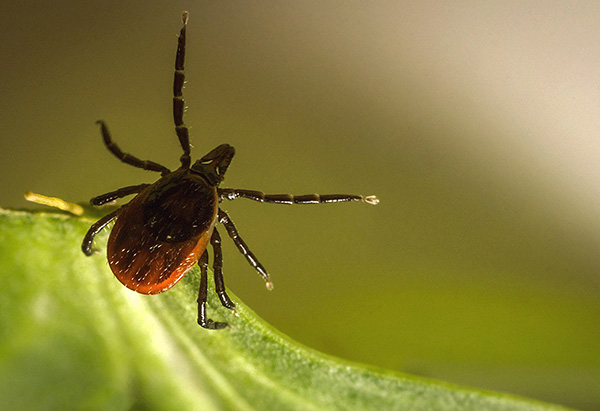
On a note
Ticks do not have a specialized organ that would help them determine the position of the body relative to the ground, therefore the animal is oriented solely on the degree of tension of certain groups of muscles of the limbs. When hunting, when the front legs are extended upward, the other three pairs hold the body in the desired position, performing both attachment and sensitive functions. Therefore, purely anatomically, the tick can neither bend on the victim, nor fall on it from the tree.
If some time after the tick senses the host, the contact did not take place, but the stimuli continue to emanate, the parasite descends to the ground and begins to creep in the direction of the victim. This is a purely instinctive process - incentives for the victim to stay and hunger force the tick to resort to active actions, even if they are, from the point of view of physiology and energy costs, unprofitable.But if the parasite still sticks in - this more than compensates for all the loss of energy and moisture at the hunting stage.
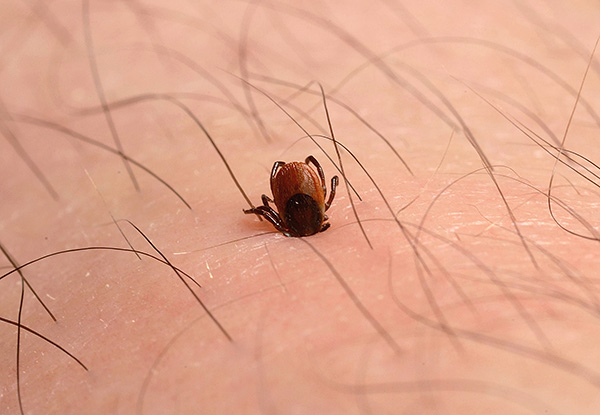
How do ticks feel the victim? First of all, by the composition of the air. The most severe irritant is the increase in carbon dioxide. Other components excreted by the body of animals are also affected, including hydrogen sulphide and ammonia.
The main distant chemoreceptor is the organs of Haller, located on the front limbs of ticks. They have the form of pits, at the bottom of which there is an accumulation of sensitive cells. These cells perceive the slightest change in the concentration of the above substances and induce the mite to act. The tick can sense a potential victim at a distance of more than 10 meters. This explains the massive concentrations of ticks in places where there is a large number of animals and people.
The question of whether ticks are heard is still controversial. Vibration of the soil, of course, is an irritant, but does not induce the parasite to action.
In addition, being a cold-blooded animal, the tick clearly senses the infrared radiation of warm-blooded organisms, but for hunting it is still a secondary irritant.
How the tick clings and keeps on the body of the host to the bite
When on the grass where a tick sits, passes a person or an animal, contact occurs, and the parasite mechanically clings with its paws to the hairline or clothing of the host. Further, its most important task will be to find a profitable place to suck. Up to this point, the parasite should be firmly on the covers and not be noticed (you need to protect yourself from the defensive actions of the host, such as shaking off, for example).

The tick clings so firmly on the body that it is almost impossible to shake it off. The only way to get rid of the tick before it stuck is to purposefully remove it from the surface of the body.
High retention on the host body is achieved due to the special morpho-anatomical structure of the mites body:
- the entire body of the parasite is covered with small spines and bristles, which increase friction and increase the likelihood of engagement;
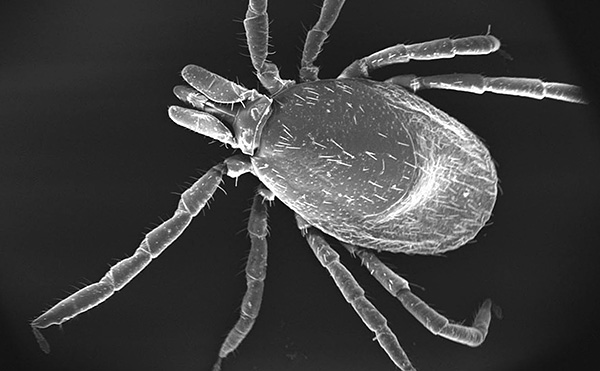
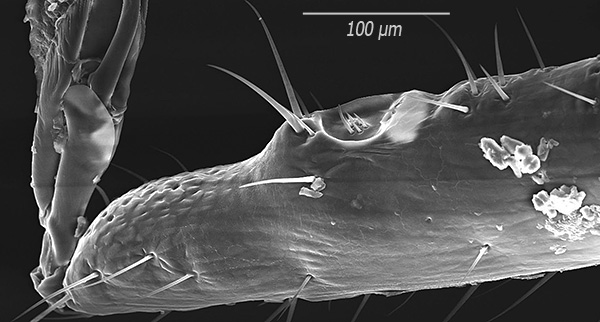
- on the legs there are sharp pair claws - they firmly cling to the fabric, like small hooks (for highly specialized ticks, the diameter of the bend of the claw can coincide with the diameter of the victim's hair, and then a kind of lock is formed, which is extremely difficult to disengage);
- some of the mites can bend the head section to their body, as if with forceps, pinching wool or tissue between the trunk and the body;
- the body is flattened in the dorso-ventral direction, which complicates the task of crushing the parasite.
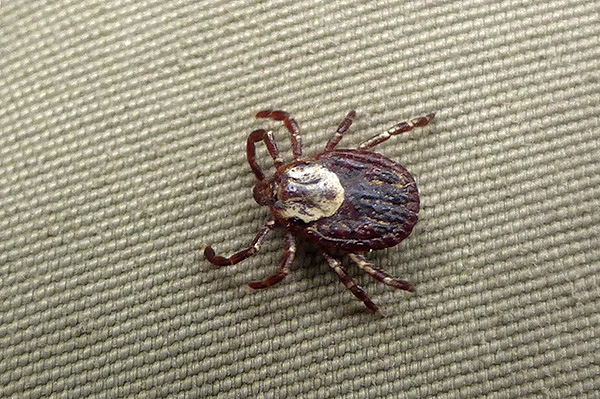
Until the tick has bitten, all these devices allow it to be on the host’s body for a long time, increasing the likelihood of a successful diet.
Given the size of the victim relative to the size of the tick, the arthropod often has to travel considerable distances, so it can take several hours to choose the bite site. Since the tick drinks blood for a very long time (usually within a few days), the process of choosing the place of attachment is extremely important, and it takes a significant amount of time.
On a note
From the above it becomes clear that the tick does not bite immediately. Meanwhile, as he gets on a man, and how he bites, there always passes a considerable period of time. Therefore, if you examine yourself after walking in nature, you can avoid the bite of the parasite.
Finding a place for suction and the initial stage of the introduction of the oral apparatus into the skin
For many species of ixodic ticks, certain attachment sites on the host's body are characteristic, where parasites are found in the greatest number of cases, whereas in other places bites occur less frequently or are completely absent.
There are a number of reasons for this tough confinement to certain places on the victim’s body. Firstly, this is an exceptional value of the ability of animals to self-purification: shaking off, licking, gnawing, pecking out and crushing the parasites. Therefore, when attached to pets, ticks look for places where self-cleaning is most difficult: ears, neck, head, near-canal and groin areas.
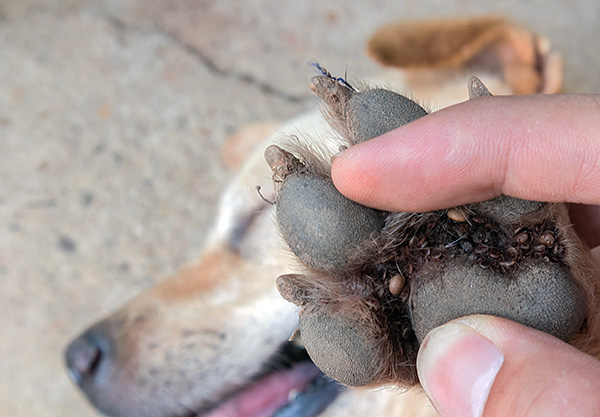

Another important factor is the microclimate in the chosen part of the victim’s body. Different skin areas have different temperature and degree of moisture, the nature of secretions and acid-base balance also differ. The ideal place for the parasite to suck should not always be under the influence of direct sunlight, otherwise the tick will quickly lose its water supply.
The actual structure of the skin is also important - how coarse it is and how well it is vascularized.
On a note
In the case of wild animals, one should not lose sight of the aggregation factor, that is, when there are many ticks on one host at once. In this case, some types of parasites choose areas remote from the place of attachment of others. Parasites form local clusters, which significantly reduces the effectiveness of local immune responses of the body-host and increases the nutritional efficiency of the ectoparasite.
Well-studied places of tick bites in humans. Shoes and clothing limit the number of places to attach, but ticks find a way out of this situation.
The largest percentage of ticks adhering to a person falls on the axillary region, then - in descending order: on the chest, abdomen, groin, buttocks, legs. In children, there is also frequent attachment to the head. It is worth noting that the ticks are perfectly oriented under the clothes, making their way to the body even through small cracks.

The structure of the oral apparatus of the parasite
The oral apparatus of a tick is a complex formation and consists of several components, each of which has its own morphology and functions. You can examine some interesting nuances in detail under a microscope (seephoto below):

The structure of the oral apparatus includes a base, proboscis or hypostomus, one pair of chelicera, immersed in cases, and a pair of palp. The base of the proboscis has the form of a capsule with a dense chitinous cover - here pass the ducts of the salivary glands and begins the throat. Palpi have a segmented structure, consist of 4 segments and perform a tactile function.
A hypostome is an unpaired chitinous plate fixedly attached to the base. It has the appearance of an elongated "sting", in which, in regular longitudinal rows, there is a large number of hooks bent back, as shown in the photos below:
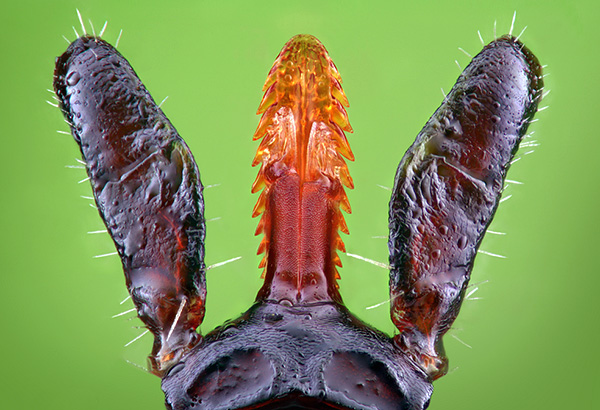
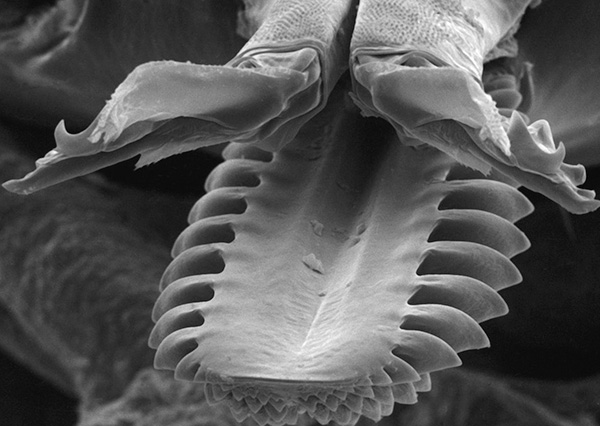
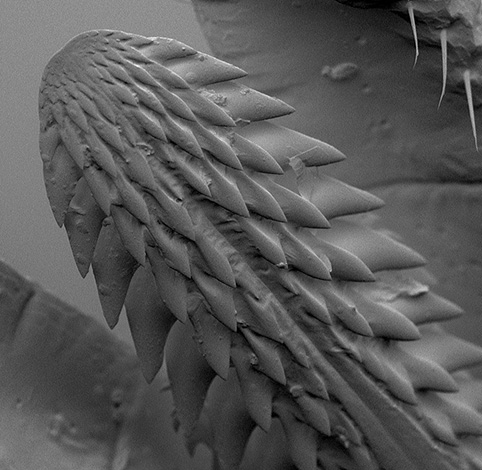
Towards the top, the hooks become smaller, forming a crown of small and very sharp spikes. When a tick bites, an acute hypostom is involved in cutting through the skin along with chelicerae.
The proboscis teeth directed back do not interfere with its penetration into the integuments, however they prevent the forced extraction of the sucking tick from being forced back, acting as an anchor. Therefore, in no case can you forcefully pull a tick out of the skin by force, as this threatens the fact that the proboscis (or even the entire head of the parasite) may remain under the skin, causing suppuration.
On a note
At the base of the hypostome, a pair of chelicers is attached, which have the appearance of sharp blades encased in cases. Chelicera are very mobile and can cut through the skin and integument at different angles and at different depths. At rest, they are enclosed in cases that save them from mechanical damage.
Collectively, this is called the gnathosome and is the anterior part of the mite’s body, which during a bite plunges into the integuments of the victim’s body.
How to bite a tick
After finding a suitable place for food, the parasite begins to dig into the skin.
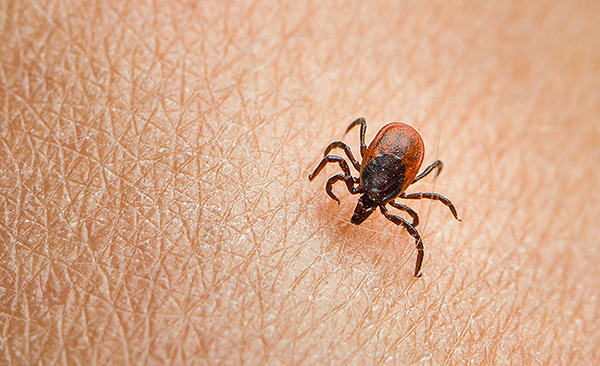
When the tick bites, it cuts through the upper horny layer of the skin, making alternate movements with sharp chelicerae. This is similar to how the surgeon wields a scalpel (only the parasite has two of them at once).
Despite the high mechanical strength of the upper layer of the skin, it does not create serious obstacles in the path of the oral organs of the tick to the inner layers where the blood vessels are located. And there is no direct relationship between the thickness of the skin of the preferred host and the length of the chelicera.
The process of cutting through the skin lasts the first 15-20 minutes from the start of the bite.
In parallel, the process of introducing the proboscis into the incision formed by chelicerae begins. The whole proboscis completely sinks into the wound, almost to the base of the head, and the palps are bent almost parallel to the skin.
As a result, the length of the gnatosome fairly accurately reflects the depth of tick penetration into the integument — during a bite, the parasite infiltrates deeply enough, and the gnatosome is located in the middle layer of skin rich in blood vessels.

On a note
Important is the fact that the mite is able to regulate the depth of penetration of the proboscis in the integument. It depends on the size of the victim and the thickness of her skin. It is necessary to take into account the fact that the deeper the tick sinks into the skin, the stronger will be the immune defense reaction of the host. Strong inflammatory processes can occur that negatively affect the tick and reduce the chances of a successful diet.
Scientists also noticed that species that are characterized by frequent changes of hosts are introduced to a shallower depth, as this minimizes the chances of injury to the parasite's gnathosome and increases the likelihood of success of the next feed.
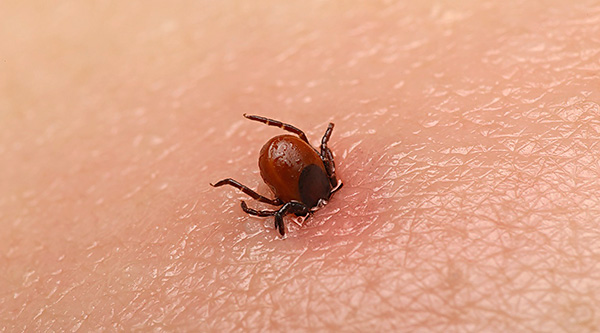
Thus, the entire stage of the bite itself (suction) lasts a long time - usually this requires at least half an hour. All this time, anesthetics are injected into the wound, so the victim does not have an unpleasant feeling or pain. (anticoagulants and some other substances are also injected with saliva). As a rule, it is possible to learn about a bite only when a parasite is found on the body.
Next comes the process of feeding the tick, a phased description of which is given below.
Parasite feeding process
After the tick squirts into the skin, it starts feeding. At this moment, along with the proboscis in the wound, there are also chelicera with cases that expand the tissues around the hypostome.
Directly from the skin, the proboscis is separated by a special cement sheath, which is a frozen discharge of the parasite's salivary glands. This case has the shape of a tube and goes into the skin a little further than the top of the proboscis.
Accordingly, food first enters the cavity of the case, and then into the pre-oral cavity of the tick. On the skin surface, this case ends with a frozen roller, to which the base of the proboscis is glued.

It is interesting
After the bite, the tick is held in the host not only by the hooks of the proboscis, but also due to the outgrowths on the cases of the chelicera, which appear to be soldered into the walls of the cement sheath.This feature increases the reliability of attachment and protects the mouth organs of the tick from inflammatory infiltrate while the parasite is drunk with blood.
It is worth noting that the tick feeds not only on blood, but also on lysed skin tissues, where the proboscis is introduced.
After the parasite has formed a cement case and is finally entrenched, the process of sucking blood begins. There is an opinion that ticks prefer a certain blood group, but this is not the case. No blood group has anything to do with choosing a victim or satiation - ticks equally often bite people with different blood groups.
At the stage of bloodsucking, anticoagulants are introduced into the host tissue, which prevent blood coagulation, due to which the parasite can feed for a long time. Additionally, digestive enzymes of saliva are injected into the wound, and the surrounding tissues partially dissolve. Because of this, a local inflammatory process is formed in the host’s body, which in some cases can spread and cause an increase in the temperature of the victim.
This is also dangerous because pathogens such as Lyme disease and tick-borne encephalitis can enter the host’s body along with the mite’s saliva.Moreover, the longer the encephalitis or Borreliosis mite feeds, the more saliva it releases and the greater the likelihood of a person being infected with the corresponding disease.
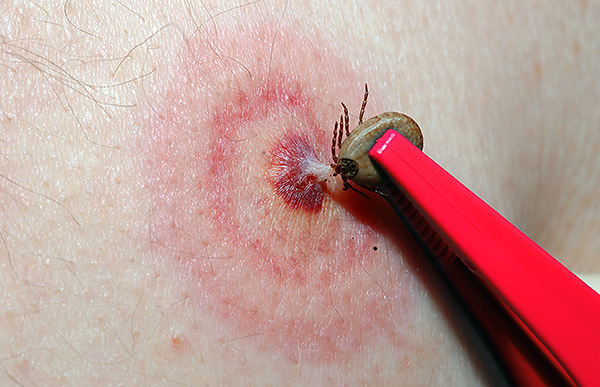
The duration of feeding of the tick varies and depends on the stage of its ontogenesis and gender. Nymphs drink blood for 2-3 days, and mature females can stay on the host’s body for up to a week. Males usually do not eat, and if the male individual sticks, it lasts only a few hours on the host.
Long-term feeding of females is associated with a clear dependence of the success of egg development on the degree of saturation of the parasite. Only fully fed females can fully mature eggs and lay them. Therefore, females ticks are the most active and dangerous for humans.
On a note
To distinguish a female tick from a male is quite simple. The male has a wide chitinous matt shield on the upper side of the body, which completely covers the back, while in the female, the shield only reaches the middle of the back.
Tick nymphs are saturated relatively quickly. They need food for molting and further development, but they are also carriers of pathogens of various diseases, as are adults.
The body size of a well-fed and hungry tick differs significantly - they can increase 25 times! And even if it was not immediately possible to notice the tick bite, then after staying on the body for a while, the parasite is hard to miss, as it becomes much larger (the fed tick looks like a gray bag or a grape).
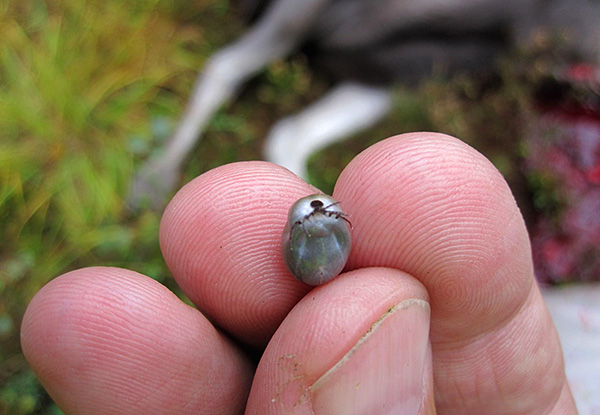
An increase in the size of the parasite's body during bloodsucking is uneven. During the first days after attachment to the host, the size of the mite’s body does not increase, but even slightly decreases, as there is a significant evaporation of water. The second stage is the longest, with the size of the tick increasing 10-20 times.
After the tick is fully fed, it will disappear. The muscles of the oral apparatus relax, the chelicera are pressed tightly against the proboscis, and the tick easily removes it from the integuments of the victim's body.
After falling away from the host, the parasite becomes free-living again for some time - it searches for a favorable place in its natural biotopes (forest, park, square) and lays eggs, prepares for molting and wintering. He no longer contacts with the former owner - his function is fulfilled, and the next stage of the life cycle of the parasite begins.
A few words about what to do if the tick has already sucked
As already noted above, due to substances that are contained in the saliva of a tick, a person or an animal does not feel the bite of a parasite. Often, people notice a tick on their body only when it has already sucked in and started feeding.
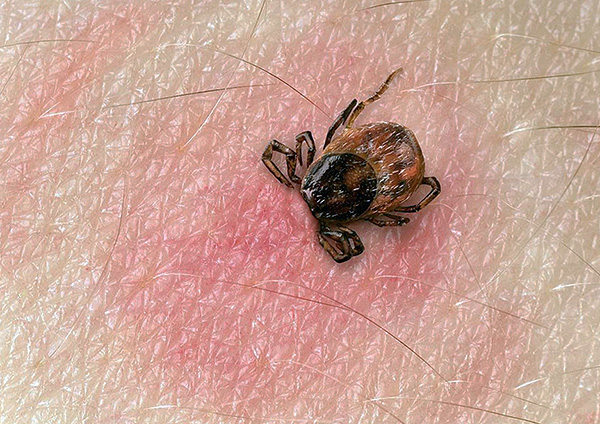
In any case, it is impossible to force him out of the skin and, moreover, try to crush him. Incorrect actions can lead to the fact that additional portions of infected saliva will get into the wound, and the parasite's head will detach from the body and remain in the wound (later it will cause suppuration).
Remove the parasite stuck need without undue delay, but as carefully as possible. You can do it yourself - there are several ways to properly extract the tick from the wound (see other articles on the site). If the bite occurred in a region potentially dangerous from the point of view of tick-borne encephalitis or borreliosis, then the tick should be taken for analysis to the appropriate medical institution. If pathogens of a disease are detected in the parasite, doctors will give further recommendations - amateur activities here can already be dangerous.
We should not forget about preventive measures.After walks, one should carefully inspect oneself, children and animals, and before going out into the nature, use repellents, wear closed clothing and shoes. With the right approach, it is almost always possible to remove the tick from the clothes (or body) in time - long before it has time to suck.
Video recording of a tick bite at high magnification - all the details of the process are visible
Is it possible to pull a tick from the skin with a syringe (vacuum): an experiment

